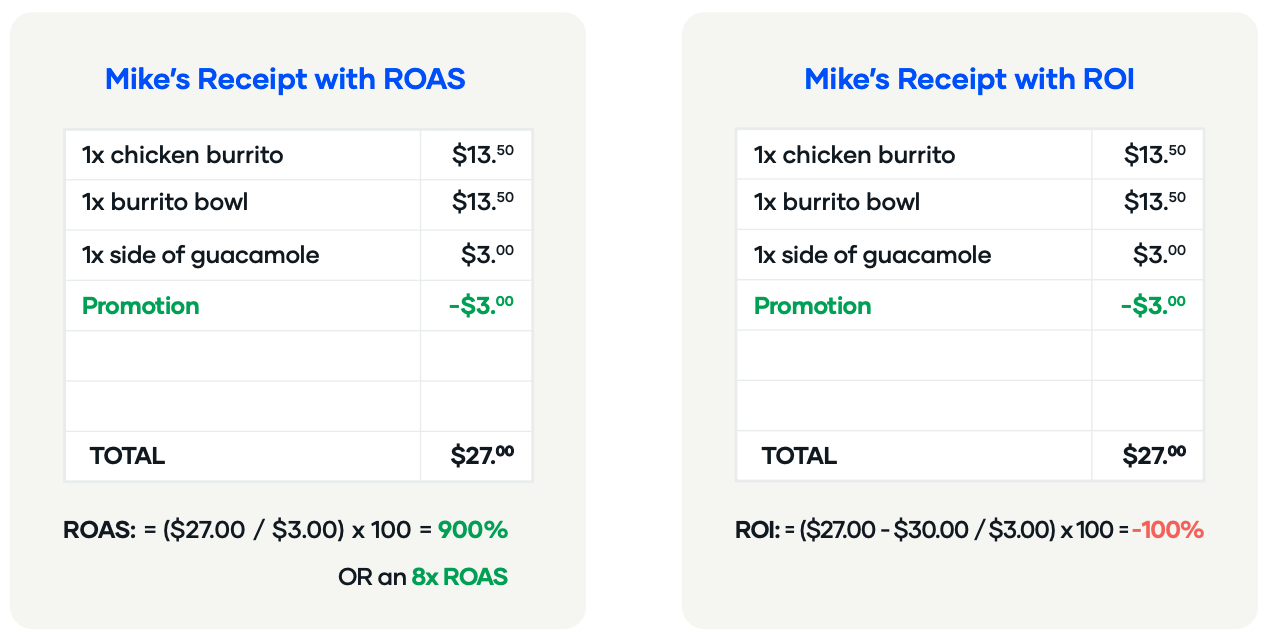Where return on ad spend falls short
Many businesses work hard to maximize their ROAS. Here’s how this metric falls short and how to measure success more accurately.

The Upside Team
Modern retail is inundated with data and insights, and it can be difficult to discern which metrics are most effective in measuring the impact of marketing and promotional efforts on a business’s bottom line.
A common measurement retailers of all industries often rely on — to varying degrees of success — is return on ad spend (ROAS). It’s a helpful measurement when other data is unavailable. But, retailers who rely on ROAS might be overlooking a big piece of the puzzle, potentially overvaluing key marketing campaigns' performance.
Let’s look at ROAS in action and how the right metrics to measure success favor strategies that create value (and profit) per-transaction.
A breakdown of ROAS
ROAS measures how much revenue your business earns per dollar invested in advertising. ROAS is calculated simply by dividing the revenue attributed to a promotional campaign by the total campaign costs for implementation.
Often, brands use ROAS to gauge the success of marketing campaigns and convert new customers. But the metric can also be applied to brick-and-mortar retailers, such as gas stations, grocers, and restaurants, to understand if time-bound promotions effectively draw in new revenue.
ROAS doesn’t tell the whole story
The inherent problem with ROAS is that the story it tells solely reflects the transactions that occur during the timeframe of a campaign. In other words, it takes credit for transactions that already loyal customers would make regardless of the campaign, thus including cannibalized sales in its measurement and overvaluing the campaign's performance.
Consider Mike, a customer who goes to a fast-casual restaurant every Monday after work to pick up dinner for himself and his wife.

Mike orders the same thing every Monday, with a side of $3.00 guacamole. The total check amount ends up the same each visit, and Mike doesn’t visit more than once per week.
Over the summer, the restaurant launched a marketing campaign with a new promotion offering free guacamole on Mondays. Mike's usual check was $30.00, and now he pays only $27.00 with this promotion. The customers who would have paid the full price now spend less every time they visit while the promotion is active.
ROAS would measure this “new” $27.00 sale as a 9x return on a $3.00 promotion — more than double the industry standard ROAS of 4x.
Would you consider this a good outcome?
Likely not.
In reality, the promotion cannibalized $3.00 in weekly sales for this customer, which comes from the restaurant’s pocket.
The more accurate measure of return on investment
In the restaurant example, ROAS didn’t account for the cannibalized sales. That cannibalization happened because the promotions were not personalized – every customer got $3.00 off their guacamole.
But marketers use ROAS out of necessity — not because they think it’s perfect. Finding true ROI is much more complicated as it demands the retailer know when a sale is being cannibalized, predicting customer behavior before a transaction.

The lesson is to invest less in broad-based ad spend and the resulting ROAS. Instead, focus on a strategy that personalizes incentives for each individual customer to change their behavior in a profitable way measurably.
Upside for personalized offers
This makes Upside so effective: one-to-one personalization avoids profit cannibalization, and incremental profit earned on every transaction falls straight to the bottom line. So, the outcome is an accurate measure of return on investment. A $3.00 promotion for Mike off his total check size motivated him to order a fountain drink, resulting in $5.00 more spent than usual, which comes to $2.00 in incremental (unexpected) revenue from that transaction.
Upside can personalize promotions for each customer by using the anonymized transaction data retailers already have to understand purchasing patterns, personalize promotions based on exactly how each individual shops, and generate offers that change buying behavior.
Learn more about how Upside can work for your business:
Share this article:
The Upside team is made up of data scientists and industry experts who are passionate about delivering empowering content to our readers. With a focus on providing practical insights and meaningful perspectives, we create engaging materials across a wide range of topics. From exploring industry trends and offering expert analysis to sharing useful tips and inspiring ideas, our team works diligently to provide you with the information you need to thrive.
Request a demo
Request a demo of our platform with no obligation. Our team of industry experts will reach out to learn more about your unique business needs.










.png)




